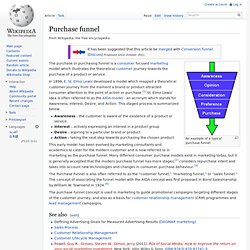

The consumer decision journey. If marketing has one goal, it’s to reach consumers at the moments that most influence their decisions. That’s why consumer electronics companies make sure not only that customers see their televisions in stores but also that those televisions display vivid high-definition pictures. It’s why Amazon.com, a decade ago, began offering targeted product recommendations to consumers already logged in and ready to buy. And it explains P&G’s decision, long ago, to produce radio and then TV programs to reach the audiences most likely to buy its products—hence, the term “soap opera.” Marketing has always sought those moments, or touch points, when consumers are open to influence. Purchase funnel. An example of a typical purchase funnel The purchase or purchasing funnel is a consumer focused marketing model which illustrates the theoretical customer journey towards the purchase of a product or service.

Awareness – the customer is aware of the existence of a product or serviceInterest – actively expressing an interest in a product groupDesire – aspiring to a particular brand or productAction – taking the next step towards purchasing the chosen product This early model has been evolved by marketing consultants and academics to cater for the modern customer and is now referred to in marketing as the purchase funnel. Many different consumer purchase models exist in marketing today, but it is generally accepted that the modern purchase funnel has more stages,[2] considers repurchase intent and takes into account new technologies and changes in consumer purchase behaviour.[3]
AIDA (marketing) AIDA is an acronym used in marketing and advertising that describes a common list of events that may occur when a consumer engages with an advertisement.

A – attention (Awareness): attract the attention of the customer.I – interest: raise customer interest by focusing on and demonstrating advantages and benefits (instead of focusing on features, as in traditional advertising).D – desire: convince customers that they want and desire the product or service and that it will satisfy their needs.A – action: lead customers towards taking action and/or purchasing. Using a system like this gives one a general understanding of how to target a market effectively.